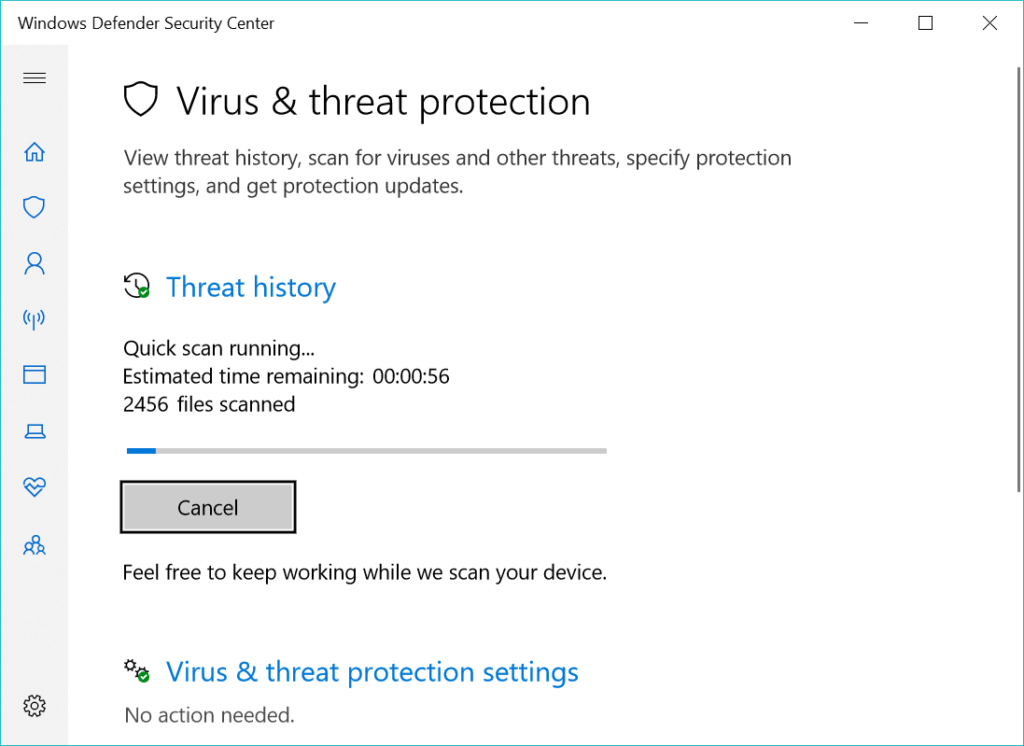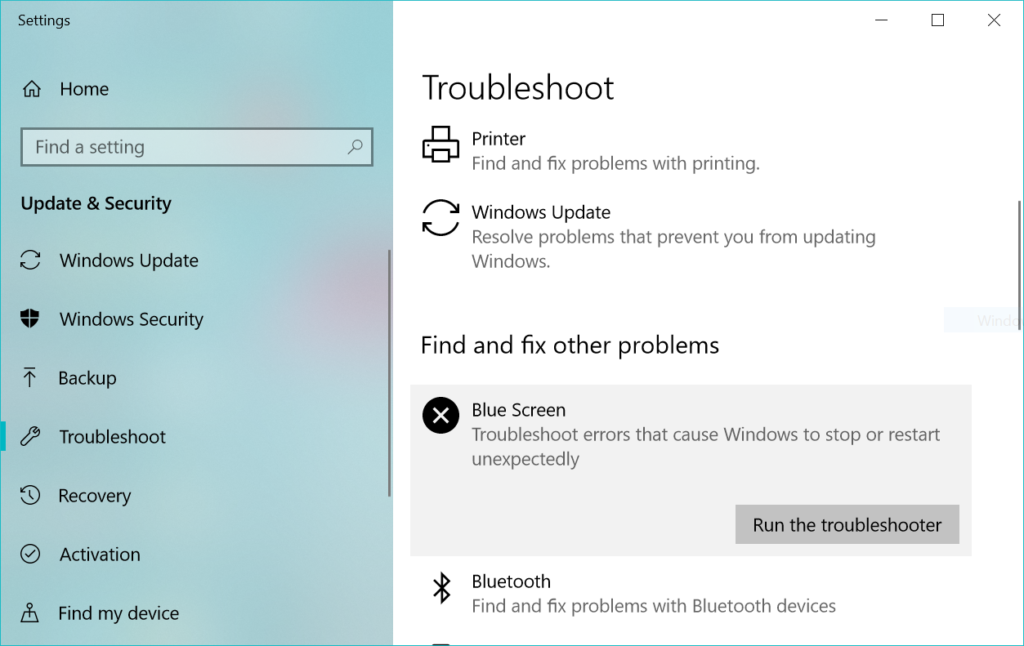| 我们致力本地化我们在尽可能多的语言的网站越好,然而这一页是机器使用谷歌翻译翻译。 | 关闭 |
-
-
产品
-
资源
-
支持
-
公司
-
在家中解决计算机问题的10条提示10 Tips for Fixing Computer Problems at Home
通过 Rachel 八月 21, 2020没有标签没有评论
计算机很棒,可以工作。不幸的是,当您的计算机出现问题时,您可能不知道如何安全地解决该问题。而且,您可能不想去计算机维修店进行任何不必要的旅行,也不希望邀请技术人员来您家。
幸运的是,许多常见的计算机问题可以通过一些简单的故障排除来解决。
下次您的计算机无法正常工作时,请尝试一些故障排除提示。
切记:始终备份计算机。
在对计算机进行更改之前,应备份重要文件。
如果发生重大故障或黑客入侵等问题,备份将是使您的PC恢复正常的最快方法。
在Microsoft.com上了解如何创建Windows 10 PC的备份 。
1.更新您的计算机
首先,更新您的计算机。当系统过时时,程序文件可能会损坏,从而导致许多常见的计算机问题。
要检查Windows 10计算机是否有更新 :单击搜索按钮,然后搜索“检查更新”。
或者,选择开始>设置>更新和安全>检查更新
2.重新启动电脑
我们中的许多人从未关闭过计算机,而是将其置于睡眠模式。
如果您有一段时间没有重新启动计算机,请关闭计算机电源。这将清除计算机的内存,并通过释放计算机的某些资源来提高性能。
3.扫描病毒

如果您怀疑计算机问题可能是由病毒或其他数字威胁引起的,请在首选的安全工具上运行病毒扫描。
Windows Defender在个人Windows 10计算机上免费。除了病毒防护,Windows Defender还提供帐户安全选项,应用程序防护等。
访问Windows Defender:单击开始> Windows Defender安全中心
当涉及病毒时,预防是关键。通过安排定期的病毒扫描来保护您的计算机和个人数据。
4.使用任务管理器关闭冻结的程序
Windows任务管理器是一个内置工具,可实时显示计算机上当前正在运行的程序。
如果您使用的程序或应用程序死机,或导致计算机滞后,则可以使用任务管理器手动将其关闭。
打开任务管理器:按住Ctrl + Alt + Delete,然后选择任务管理器
要在任务管理器中关闭程序 :在任务管理器中,选择“查看应用程序”选项卡>选择要结束的程序>单击“结束任务”
注意:这将不允许您在关闭应用程序之前保存进度。
5.在Google,论坛或Reddit上搜索帮助
只需在Google或YouTube中输入问题即可快速解决问题,您可能会感到惊讶。您可能会发现数十个或数百个用户遇到与您相同的问题。您可能会找到一个快速的解决方案-甚至是一个简单的分步视频教程。
如果您在第一次尝试中找不到与您的问题相关的答案,请重新编写搜索词,直到出现更相关的内容为止。添加一些细节或带走一些。
如果您有需要解决的特定问题,请访问技术论坛。大多数软件或硬件公司都有提供客户支持的论坛。
例如,Microsoft具有Microsoft支持和Microsoft Answers社区 。
只需搜索您需要的论坛,然后详细说明您遇到的问题。您可能会从经验丰富的用户那里得到一些有用的答复。
Reddit.com还是一个出色的工具。 TechSuport subreddit是一个不错的起点,但是还有无数其他可以提供支持的subreddit。您正在使用的软件或硬件甚至可能具有子目录,您可以在其中发布问题。
确保让论坛用户知道您拥有的PC和软件版本,以便他们能够提供最佳帮助。
6.运行Microsoft故障排除

多年来,Microsoft已经创建了复杂的,用户友好的工具,以帮助解决和修复常见的计算机问题。
访问Microsoft的故障排除工具:单击开始>设置>更新和安全性>故障排除
选择您要解决的问题,然后选择“运行疑难解答”。
7.更新或安装驱动程序
如果您在连接硬件(例如打印机,路由器或图形卡)时遇到问题,则可能是驱动程序出现问题。简而言之,计算机驱动程序是至关重要的软件,它使您的计算机可以与硬件和其他软件进行通信。
您的计算机应预装所有必需的驱动程序。但是有时会出现小故障,驱动程序可能会过时或损坏。
通常,更新计算机将解决驱动程序问题。但是,如果问题仍然存在,则可能需要安装新的驱动程序,重新安装旧的驱动程序或完全删除驱动程序。
ReviverSoft驱动程序Reviver可以为您管理驱动程序。但是,您也可以使用Windows设备管理器手动管理驱动程序。
要打开Windows设备管理器,请执行以下操作:单击搜索按钮>搜索设备管理器>选择设备管理器>选择操作,然后扫描硬件更改
8.运行Windows系统还原
系统还原是Windows的一项有用功能,基本上可以在特定时间点(称为还原点)对计算机及其所有重要设置进行“快照”。
然后,您可以将计算机“重置”到以前的还原点,从而允许您擦除任何引起计算机问题的不必要更改。
但是首先,您必须启用系统还原并创建一个还原点。
设置系统
恢复:- 搜索“创建还原点”并选择最佳结果
- 在“系统保护”选项卡中,选择(系统)驱动器,然后单击“配置”。
- 选择打开系统保护
- 单击应用,然后单击确定
只要您更新计算机,或使用“创建…”按钮手动创建一个还原点,Windows就会自动创建一个还原点。
使用系统
恢复:- 搜索“创建还原点”并选择最佳结果
- 在“系统保护”选项卡中,选择“系统还原”,然后按照提示进行操作
9.整理硬盘碎片
想象一下一个整齐的文件柜。想象一下,每次需要一个文件时,都会拉出该文件夹,但是不会将其放回原处。随着时间的流逝,您的文件柜将变得混乱不整洁,并且需要更长的时间才能找到所需的信息。
随着时间的推移,这基本上就是计算机注册表或内部文件柜发生的事情。
我们建议ReviverSoft Registry Reviver清理或整理注册表碎片。但是你可以自己做。
按照Microsoft的步骤对Windows 10 PC进行碎片整理 。
10.重新安装操作系统
重新安装Windows是一个“最后尝试”的解决方案,在绝对没有其他解决方法时,请尝试使用该解决方案。
仅在绝对必要时才应该这样做?重新安装Windows操作系统就像将计算机擦干净并重新开始一样,这意味着所有文件,程序和保存的信息都将丢失。
但是,有时这是唯一的选择。
如果是这种情况, 请首先备份您的重要文件 。然后享受您的新鲜“像新”计算机!
当我们的PC出现问题时,我们很容易想到我们需要昂贵的专业解决方案。但是,通过一点点调查自己解决技术问题有多么容易,我们中的许多人常常感到惊讶。
Was this post helpful?YesNo
没有找到答案?问一个问题向我们的专家社区来自世界各地,并得到在任何时间在所有的答案。把它钉在 Pinterest 上